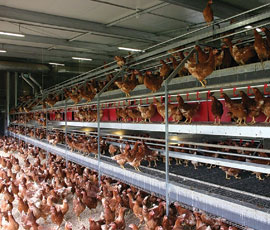Getting the best from multi-tier

As an industry, the free-range sector is on a steep learning curve when it comes to managing multi-tier free-range houses, according to Paul Turley of Vencomatic.
“Over the last few years multi-tier has really taken off and we are all still learning things,” he told the Severn Valley Discussion Group meeting, “The big difference with traditional or multi-tier systems is you’ve actually got to manage the birds.”
PULLETS
Rearing was the key to success: “If the rearing’s not right it isn’t going to work.”
As with traditional systems, it was important to have uniformity and correct development. But there were extra steps needed to prepare the birds for the multi-tier environment.
Birds needed to be accustomed not just to jumping on a slat, as in a traditional free-range system, but also to jumping to different levels, and also jumping to a perch.
“This is critical for any multi-tier system, and the birds have got to be trained to do it. You must get them used to a slat, but they need to get used to perching as well.
“There are so many systems where you can see the bird behaviour. They don’t know what a perch is and are not comfortable – ideally they need to be from day one.”
The aim was to try to recreate the environment they would find when they moved into a multi-tier. Ideally a purpose-made starter unit should be used, which included the manure belts found in the laying unit.
“The big problem with that in the UK is the cost, as we can’t get adequate returns on the pullets. That’s why we make the best of what we can do with the rearing systems that we’ve got and the use of platforms.
“We haven’t spent that much money on rearing systems in the UK, so what we’ve tried to come up with is a middle of the road type system. What we tend to do is provide different level platforms, basically to give the birds two levels to jump up and down on, and to get used to resting on slats.”
There should be drinkers on every level, said Mr Turley, with mushroom aluminium perching on top of that. Feeders should have perches on top too, as in the laying system.
“If you’re placing a bird, and it’s not seen a perch on top of a feeder, it isn’t going to know what to do. You’re going to have to do a lot more work training it.”
LAYING SYSTEM
With the actual laying systems, the majority were now designed along similar lines, he said, being fully integrated with nests, feeders and drinkers all incorporated in one system.
“The benefits of this are perfect bird movement throughout the system, and the birds have good escape possibilities.
“What you should tend to find is reduced aggression and mortality, because birds can find a pecking order and flocks are a lot calmer.”
While traditional free-range systems often gave rise to “flighty” flocks, this was less common with multi-tier units.
Another benefit was reduced floor eggs.
“In a traditional system, you’ve got a two-tier nest typically straight down the middle,” said Mr Turley. “So the only access is from the left or right. If you put in a two-row multi-tier system, the birds have got to travel a lot less distance to find a nesting area.”
LIGHTING
Correct lighting was also a vital part of successful multi-tier management.
Whichever system was used, there should be four groups of lights: underneath the bottom manure belt; internal lights within the actual system; main house or passage lights; and perch lights.
“What I always advocate is to have each group on a separate time clock, so the lighting can be phased as needed.”
A typical sequence would be to switch the bottom lights off first, and then 20 minutes later take out the main passageway light. This pulled the birds out first into the passageway, and then up into the system.
After another 20 minutes the internal light should go out, leaving just the perch lights for the last 20 minutes.
“That’s a rule of thumb, but you will probably have to change things depending on what your flock’s telling you,” he advised. For example, when the final perch lights went out, if there were still some birds sticking on the litter, the system lights could go back for another 20 minutes to bring in the stragglers.
